Peru 3 – Machu Picchu…the Trek
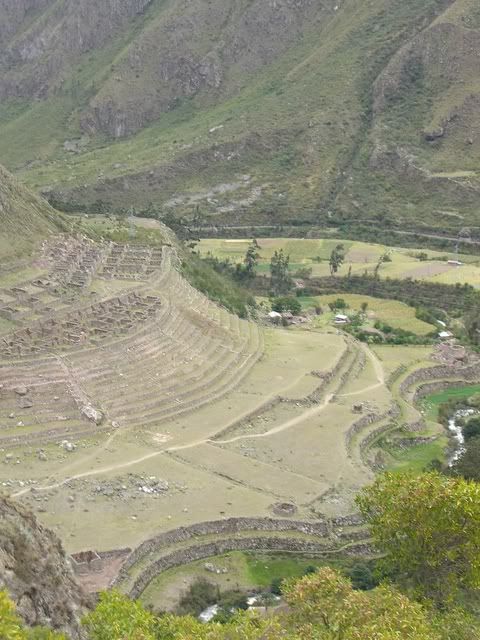
Ruins of Patallacta
Hola chicos and welcome back to the Extravaganza blog. Sorry for the delay but since special-guest-star-Lindsay arrived it has been action-packed around here. We’re back from both Machu Picchu and the jungle so watch for lots of new posts in the coming weeks. Entonces…

Me at the start of the trek…clearly beauty is not a priority on this trip
Machu Picchu…perhaps the most famous of tourist attractions in South America…certainly the most famous in Peru. As we learned in the last post, the area surrounding Cusco and the Sacred Valley of the Incas was formerly part of the vast Incan empire way back in the 15th and 16th centuries before the arrival of the Spanish. It was built around 1450 and abandoned about 100 years later after word came of the arrival of the Spanish throughout the rest of the empire. Multiple theories abound as to the useage of this fortress though none have been proven thus far. Lots more on this and the rest of the history at everyone’s favorite information site: Wikipedia.

Now the interesting, and most significant, thing about MP is that despite the fact that it is a mere 50 miles from Cusco it was never found nor destroyed by the Spanish as the rest of the Inca sites were. In fact, MP remained unknown (read: unknown to white people) until 1911 when Hiram Bingham, a Yale University lecturer “discovered” it overgrown and high upon a hill in the Sacred Valley. You might expect that the Peruvians would be none-to-thrilled that ‘ol Hiram exposed their treasure to the world. On the contrary…capitalism is alive and well here in Peru and Hiram is just short of revered for bringing an enormous source of capital into an otherwise poor country. Much more on the history and other goings-on in the Sacred Valley in the next post after our arrival at MP.
Ok, so there are several ways to get to Machu Picchu:
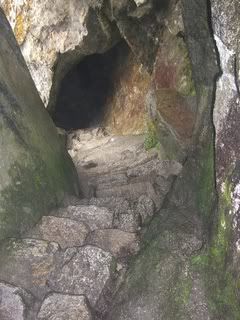
- Take a train from Cusco or Ollantaytambo (see Peru 2 for details on this charming town) to Aguas Calientes which is the nearest town to MP. Then take a bus up to the ruins with the rest of the masses. Best for non-fit people, those with little time and those who enjoy crowds.
- Spend the night in Aguas Calientes and take the first bus up to the ruins at 6 am before the crowds arrive. Best for the non-fit, those with little time and those who do NOT enjoy crowds.
- Take one of the several treks along the Inka Trail (the stone-paved road used by the Incas to travel between Inca sites). These can vary in length from 2 days up to a week though the Classic Trail is 4 days/3 nights and is the most popular option. We opted to do the Classic Trail which includes 3 days of hiking, 3 nights camping along the trail and on the 4th day…arrival in MP before the crowds. Warning: this trek is not for the unfit or faint of heart.
So Lindsay and I signed up for the Classic Trail along with 14 other tourists, 22 porters to carry all of our supplies (including the chef) and two guides. The first day is billed as the “Easy Day” and one that is to train the trekkers for the following…much tougher…two days. Day 1 wasn’t too bad and despite the fact that we were trekking in the beginning of the rainy season we only got a few sprinkles on that first day (though we heard 6 people in another group turned back after the first day). In total, the entire length of the Inka trail is 44 kilometers (just over 27 miles) which includes a total elevation gain of 1,600 meters (5,250 feet) and 3 mountain passes.

First Pass…Dead Woman’s Pass
As I mentioned, we had 22 porters along who carried all of the our gear, tents, food, gas for the camp stove, dining tent, table and chairs. Let me say from the outset…these guys are truly amazing. The Inka Trek was hard enough for us who were just carrying a daypack with water, camera, jacket, etc….but these guys each carried up to a maximum legal amount of 20 kilos (45 pounds) though I suspect some of them were carrying more weight than that. Not only were they carrying a lot more weight than we were…they were doing it in flimsy leather sandals and in many places were literally running along the trail. Our guide insisted we call them chaskies (which means fleet-feeted runners in Quechua) rather than porters…either way they were truly amazing people. I’ve included a picture here of the whole crew…our youngest porter was 20 and the oldest 63 and all are of Quechua (Incan) ancestry and live in the surrounding communities.

The Trekking Crew in Total
There are beautiful views and lots of ruins along the Inka Trail though unfortunately a lot of the pictures were not great as things were shrouded in fog. The second day of the trail is considered the most difficult as it is straight up the mountain to the first pass known as Dead Woman’s Pass. They were not kidding…it was a challenge though Lindsay and I were suprised to be among the most fit in the bunch despite the fact we were the 3rd and 4th oldest out of the 16 trekkers. Day 2 was rough and as you can see from the pictures, rainy and cold. On the other side of Dead Woman’s pass we descended about 600 meters to the second campsite at Runkurakay and some much needed sleep.
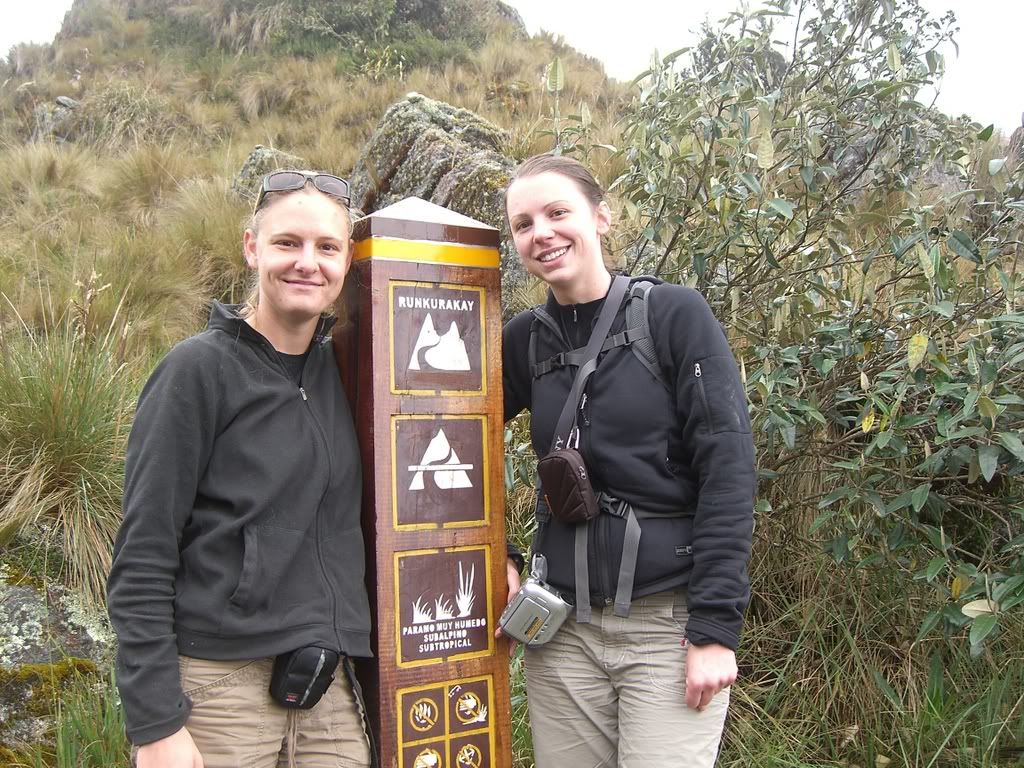
Second Mountain Pass at Qochapata
The morning of the third day was my favorite as we weren’t going up anymore and we were descending into the cloud forest terrain so things were becoming much more tropical. By lunchtime the sun was shining…but we should have known better. Soon after it started pouring. And by pouring…I mean pouring. By this time we were going down the mountain along stone stairs and there was a virtual river accompanying us on this journey. It was only at the point that my socks became wet that I became miserable. We eventually made it to the final campsite and were rewarded with a much needed cerveza. The 4th and final day is yet to come…until then…

Third Mountain Pass at Phuyupatamarka
Here are a few things learned on the Machu Picchu trek:
- Sometimes going down is much more difficult than going up…1000 meters worth of steps is very, very hard on the knees.
- A person can handle a little bit of rain and dampness…even enjoy it some as it keeps you cool…until your feet get wet. Then all bets are off.
- Rice is actually one of the 5 major food groups (though really, our food was amazing considering the conditions upon which it was prepared).
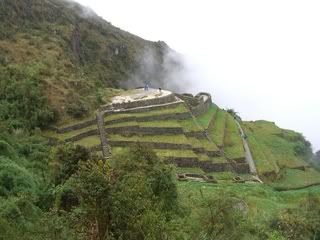
Ruins of Phuyupatamarca
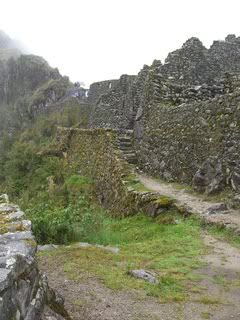
Ruins of Runkurakay
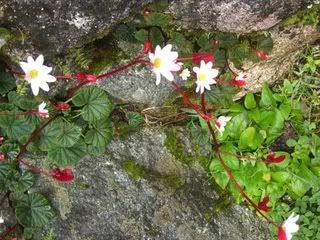
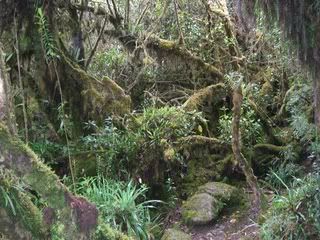



Don’t we look warm?
Tags: 9 - Peru, Cusco, Inka Trek, Machu Picchu, Sacred Valley

December 24th, 2007 at 4:58 pm
I am impressed! I’m not suprised that you two are fit. If your mom had been along you could have named Dead Woman’s pass after me and you could have buried me there
What and adventure!
December 31st, 2007 at 7:25 pm
I have so enjoyed your travels. I think you would be saying good by to me along with your mom at dead womans pass if I were treking with you. Have fun and Happy New Year
January 3rd, 2008 at 4:57 pm
Hello Stacey-
Which tour group did you do the Inca Trail with and would you recommend them?
Thanks,
kate